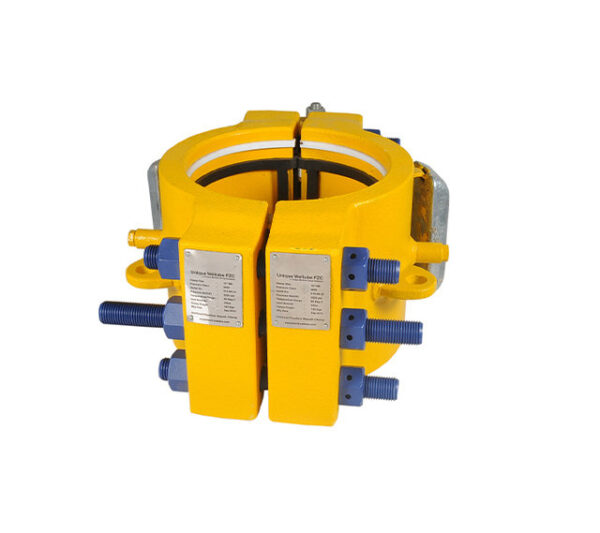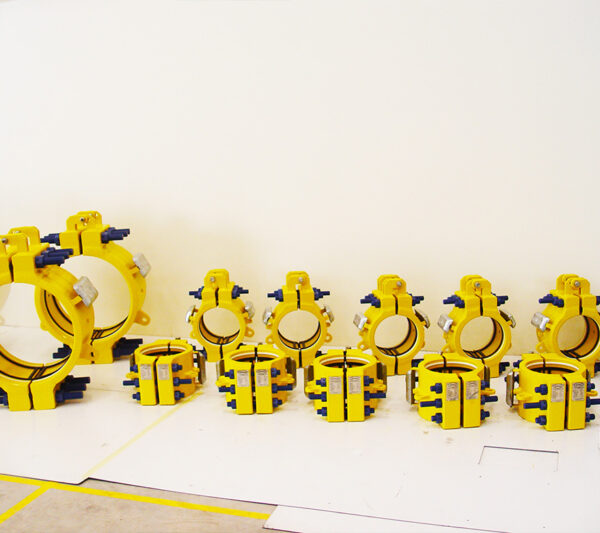Features
- Coded for material identification and traceability
- Provided with material certificates
- Manufactured and delivered to your quality control specifications
- If required, we can also perform Radiography Testing, Ultrasonic Testing, Magnetic Particle Examination, Hydrostatic Testing, and Destructive & Non-Destructive Testing
Specifications
- Engineered and extruded with outlets from 2” to 48”
- Equipped with a welding neck flange RF according to ANSI Class 150, 300, 600 or 900
- Larger sizes and pressure ratings are available
Applications
- Oil pipeline
- Gas pipeline
- Water pipeline
Streamline Your Operations with Wellube’s Top-notch Line Stop Fitting Services
p>A line-stop is a way to isolate a live pipeline to provide a shut-off during an emergency, a temporary work project, or when you need to connect a new pipeline. One widespread misunderstanding about a line stop is that the pipeline must be shut down. When utilised in conjunction with a temporary bypass, the pipeline can continue to operate normally without interruption.
Whether you are performing scheduled or emergency repairs, maintenance, alterations, or reconfiguration of existing piping systems, Wellube’s line-stop services are cost-effective.
It is the last option before closing or draining a plumbing system. Line stops can be used on any pipe material or product.
What to expect during the line stop fitting services?
Line stops are used to temporarily shut down a pipeline system so that improvements or repairs can be completed.
Line stops allow a system to continue operating normally without interruption. Line stops are possible on practically any type of pipe with pressures or goods under pressure.
A specific flanged line stop fitting, a temporary valve, and our actuator are used in the line stop action. The line stop fitting is placed and tested, as is the temporary valve, and the hot tap is finished. After installing the hot tap, we attach the line stopping head and install the line stop actuator. Line stop heads are removed after the required work is completed, and completion plugs are installed.
Our engineers removed the temporary gate valve because the completion plug seals at the line stop fitting’s flange. The line stop fitting is finished by attaching a blind flange on top of it.
If necessary, the line stop fitting can be utilised again in the future.
The line stop fitting process
Line stopping, also known as line plugging, is a method of isolating a section of a piping system from the remainder of the network. All adjustments and repairs can be performed in the isolated section of the pipeline without disrupting service to the rest of the network. When there are no existing shut-off valves nearby, or they are not functional, this method works as a temporary shut-off valve.
The line-stopping method begins with welding the line-stop fittings into place; if the pipe material cannot be welded or welding is not permitted, a mechanical clamp fitting is utilised. After the fitting is in place, the specialists will insert the temporary line stop valve and hot tap the main. After the hot tap is finished, a mechanical plugging head is put into the pipe. The mechanical stopper head is then tightened, limiting the flow in the pipe. Wellube primarily uses mechanical plugs with high tolerance areas to provide a dependable and flexible solution to new and existing pipelines in any condition.
Method
- Begin by assessing the specific needs of the line fitting job. Determine the line type, dimensions, and required connection points. Evaluate the probable difficulties and create a complete plan for the fitting process.
- Our professionals verify that all necessary tools, equipment, and materials are present before beginning the line fitting. Clear the work area and make sure all safety precautions are in place. We determine the line’s access locations and make any necessary alterations or modifications.
- Wellube engineers meticulously measure and mark the line at the desired connection places. Making precise cuts with proper cutting tools, ensuring the ends are clean and free of burrs or dirt.
- Line stops should be installed at the indicated connection sites. Line stops are temporary seals that prevent fluid or gas from flowing during the fitting procedure. We ensure that the line stops are firmly fastened and can withstand the pressure exerted by the line.
- Choosing the proper fitting type based on the line specs and connecting needs. Use thread sealant or other essential sealing agents to achieve a leak-proof connection.
- To assure the integrity of the line fitting, Wellube technicians do extensive testing and inspection. Pressure testing, visual inspection, or the use of specialised equipment may be used to detect leaks or anomalies.
- Restore the line to its regular working condition after the line fitting has been successfully installed and tested. Remove the line stops, re-establish fluid or gas flow, and check the fitted line’s functionality.
- We evaluate the overall performance and efficiency of the fitted line when the line fitting operation is completed. Monitoring the operation, assessing potential problems, and making necessary modifications or enhancements.
Wellube as the Industry’s Choice for Line Stop Fittings
The best option for pipeline maintenance or repair is Wellube’s line stop fittings. Almost any distribution pipeline, including those carrying oil, natural gas, and other fuels, is safe to use with our line-stopping equipment. Provides individualised support for line stop installation during pipeline rehabilitation.
Our fittings have outlets ranging from 2″ to 48″ with a welding neck flange RF in accordance with ANSI Classes 150, 300, 600, or 900. There are options for larger diameters and pressure ratings.
If required, we can perform the following:
- Radiography testing
- Ultrasonic testing
- Magnetic particle examination
- Hydrostatic testing
- Destructive and Nondestructive testing.
Leave your enquiry through the form to get a call back from our engineers and specialists.









 Availability :
Availability : 




